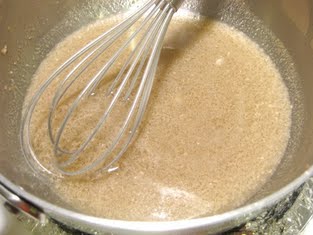Suet
Today there are TWO posts for the Daring Baker's challenge. This post focuses exclusively on rendering your own suet (the cow equivalent of lard). It's super easy to do, once you can find the suet that is.
From what I can tell, this english pudding has very humble beginnings. Any dessert recipe using fat from a cow (to use up as much of the animal as one could) and bread crumbs has to have humble beginnings. Ironically though, the only place I could find suet was the fanciest supermarket in town: Draegers.
I so rarely shop at Draegers because I don't make $150,000 a year, but I love going in there. So much variety, such good quality food... and they not only KNEW what suet was, they had it. Luckily for me they save their suet, grind it, and freeze it. It looks like little pebbles of fat.
But you cannot, I repeat, CANNOT use the suet as it is right now. Why? Well, unless you like your cake tasting like ground beef, I suggest you listen to me.
What you have to do is render the fat, or separate it from the cow parts. It looks like pure fat, but it's really not.
To render the fat, melt the suet on a medium/low heat.
Halfway through it'll look like this. Sorry, it looks kinda gross.
Once it's all melted it'll have a brownish tinge to it. This is why you want to separate the fat from any meat left on the fat.
To do that, use a cheesecloth and strain the suet. Can you see the clear fat below?? Good!
Now just to be sure, I went ahead and repeated the process one more time (returned the fat to my pan, heated it for a minute or so to make sure it was melted, and restrained it). But you can already see how clear it really is.
Suet is an interesting thing. It has a really low melting temperature, but also seems to get hard very quickly. Just a little drip on my finger instantly turned into a hardened, greasy crust. The best way to describe it is a cross between crisco and wax. So weird!
Anyways, once you've strained the suet (at least 2X), place it in a container and stick it in the fridge or freezer (if you'll be storing it for a long time). It turns into a solid block of pure-white suet.
To use this suet in recipes, I found the best way was to just grate it (using a box grater). Shaves it into nice small pieces that distribute well into the dough. (Ignore the blue tinge in the photo- I don't know why that happened...)
And there you have it, rendered suet to use in pastry doughs or steamed British puddings.
Buen Provecho,
Jackie
From what I can tell, this english pudding has very humble beginnings. Any dessert recipe using fat from a cow (to use up as much of the animal as one could) and bread crumbs has to have humble beginnings. Ironically though, the only place I could find suet was the fanciest supermarket in town: Draegers.
I so rarely shop at Draegers because I don't make $150,000 a year, but I love going in there. So much variety, such good quality food... and they not only KNEW what suet was, they had it. Luckily for me they save their suet, grind it, and freeze it. It looks like little pebbles of fat.
What you have to do is render the fat, or separate it from the cow parts. It looks like pure fat, but it's really not.
To render the fat, melt the suet on a medium/low heat.
Halfway through it'll look like this. Sorry, it looks kinda gross.
Once it's all melted it'll have a brownish tinge to it. This is why you want to separate the fat from any meat left on the fat.
Now just to be sure, I went ahead and repeated the process one more time (returned the fat to my pan, heated it for a minute or so to make sure it was melted, and restrained it). But you can already see how clear it really is.
Buen Provecho,
Jackie











Comments
Post a Comment